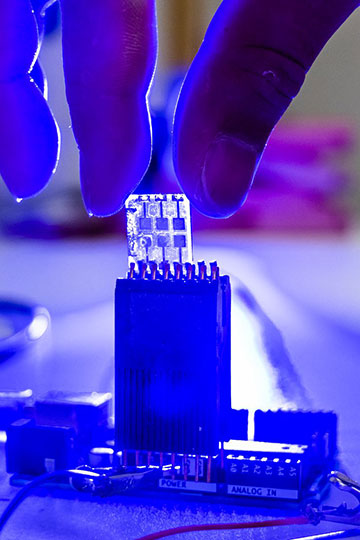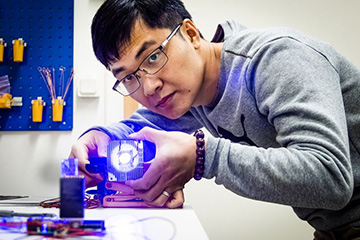![]()
A team of researchers from China and Sweden developed a photodetector made from a film of inorganic perovskite, and used to detect and transfer data (including text, images and audio) transmitted via visible light across free space. [Image: Thor Balkhed]
The materials called perovskites—which combine cheap, simple manufacturing processes with good semiconductor specs—have attracted a lot of attention as a potential low-cost platform for solar cells and LEDs. Researchers would also like to put those same qualities into service in photodetectors, for high-bandwidth applications such as free-space visible-light communications (VLC), popularly known as “Li-Fi.” But it’s been tough to develop perovskites that combine a rapid response time and high sensitivity with long-term operating stability.
A research team in Sweden and China have now put an inorganic perovskite photodetector on the table that, the researchers maintain, can bring these characteristics together in a single device (Adv. Mater., doi: 10.1002/adma.201803422). The perovskite photodetector that the group tested clocked in with sensitivities on the order of tens of picowatts per square centimeter, and response times in the tens of nanoseconds—and remained stable for a lifetime of 2,000 hours. The team even tied the perovskite photodetector into a simple Li-Fi system, and showed that the detector could efficiently receive a signal containing text and music from an LED transmitter.
From photovoltaics to photodetectors
Metal-halide perovskites constitute a family of materials with a specific crystal structure that includes a large metal cation, a smaller metal cation, and halogen anions that bind them together (see “Perovskite Photovoltaics,” OPN, November 2014). The materials have attracted optoelectronic interest partly for their favorable band-gap characteristics and high carrier mobility.
But perovskites are also attractive because they’re lightweight and flexible, and can be manufactured through low-temperature, solution-processed techniques. Those virtues have raised the possibility that these materials could emerge as a low-cost alternative to conventional, silicon-based photovoltaics, if the perovskites can be brought up to a reasonable level of efficiency. And a lot of research in the past decade has focused on doing just that.
In principle, perovskite’s qualities look equally good for photodetector applications, positioning them to compete with expensive silicon and InGaAs solutions. But, according to the research team behind the new work, it’s been tough to simultaneously realize the level of high sensitivity, rapid response times and long-term stability that broadband optical communications and imaging applications would require.
As a result, much of the research on photodetector alternatives to silicon and InGaAs has focused on organic semiconductors and quantum dots. Those alternatives, however, have relatively low carrier mobilities and thus too low of a response speed to be practical for broadband optical communications.
Optimizing architecture and chemistry
To find a perovskite that might work as a photodetector for Li-Fi, the research team—led by Wenjing Zhang at Shenzhen University, China, and Feng Gao at Linköping University, Sweden—started out by focusing on photodetector architecture. Previous work had suggested that p-i-n diode structures scored much better in sensitivity and response speed than metal-semiconductor-metal architectures. So the team opted to build its photodetector stack on the p-i-n diode model.
Meanwhile, to achieve long-term stability, the researchers looked to chemistry, gravitating toward an all-inorganic cesium halide perovskite (AIHP) formulation. These inorganic formulations had been lauded in previous studies for their robustness, relative to the comparatively short stable lifetimes of the organic-hybrid perovskites that had featured in some earlier work. The specific perovskite formula used by the China–Sweden team, CsPbIxBr3-x, combined cesium and lead as the metal ions, with iodine and bromine as the halogen component.

[Image: Thor Balkhed]
Fast, sensitive, durable
The photodetector prototype that the team developed from these principles sandwiched a slab of the CsPbIxBr3-x material between two polymer layers—one serving as the photodetector’s hole-transport layer and one serving as the electron-transport layer. Another thin polymer layer on top contained an array of silver electrodes to tap the resulting photocurrent from the detector.
In tests of the device, the researchers found that, through a number of optimizations, they could hammer down the detector’s dark currents, a key source of noise, to very low levels, and also achieve a sensitivity to weak light on the order of 21.5 pW/cm2. The detector reportedly showed a good linear response to light intensity as well, across ten orders of magnitude—a dynamic range of around 200 dB. The response speed, at 20 ns, surpasses, according to the authors, that of all reported AIHP crystal photodetectors, and is comparable to that of the best hybrid-organic perovskite photodetectors.
On the stability front, meanwhile, the team reported that the devices showed “little difference” in photocurrent and dark current after 18 hours of continuous operation, and only “negligible degradation” of the photoresponse after 2,000 hours of aging at room temperature. Hybrid-organic perovskites, by contrast, have shown a decrease in photoresponsivity of some 50 percent after around 700 hours of aging, according to the study.
“Für Elise,” via Li-Fi

Postdoctoral researcher and lead author Chunxiong Bao sets up experiment for visible-light communication (VLC) with LED and the perovskite photodetector. [Image: Thor Balkhed]
In a final demo, the team tested the photodetector in a simple Li-Fi setup consisting of two computers, one tied to a blue LED and one to the perovskite photodetector device. The researchers showed that they could pass text strings from one computer, encoded as intensity modulations, to the LED light, and then across free space to the photodetector; those received modulations, in turn, were decoded and displayed as text by second computer. The team was even able to pass an audio stream—a pop-style version of Beethoven’s “Fur Elise”—across the free-space link in the same way.
The authors bill this demo as “the first perovskite detector-based prototype signal receiver” for VLC. The results, they conclude, “suggest that high-speed and stable perovskite detectors may have great potential for optical communications applications.”
Closing the gap to commercialization
Getting to those applications could take some time, according to co-team-leader Feng Gao at Linköping. One disadvantage of the new photodetectors, for example, is that they include lead, which has raised environmental concerns in the perovskite-photovoltaics market. In an e-mail to OPN, Gao said that the team is working on lead-free perovskite detectors as well, and has recently made “some great progress” in that effort that’s soon to be published.
Meanwhile, though the team’s recently published demo showed gains in speed and lifetime of perovskite photodetectors, there’s still “a big gap to commercial p-i-n or avalanche photodiodes for communications,” according to Gao. His team is now working to close the gap to improve speed and stability still further. “We hope that we can obtain a high speed of hundreds of MHz, or even GHz,” he said.
In addition to Shenzhen University and Linköping University, researchers from Southeast University and Nanjing University, China, were also involved in the work.
